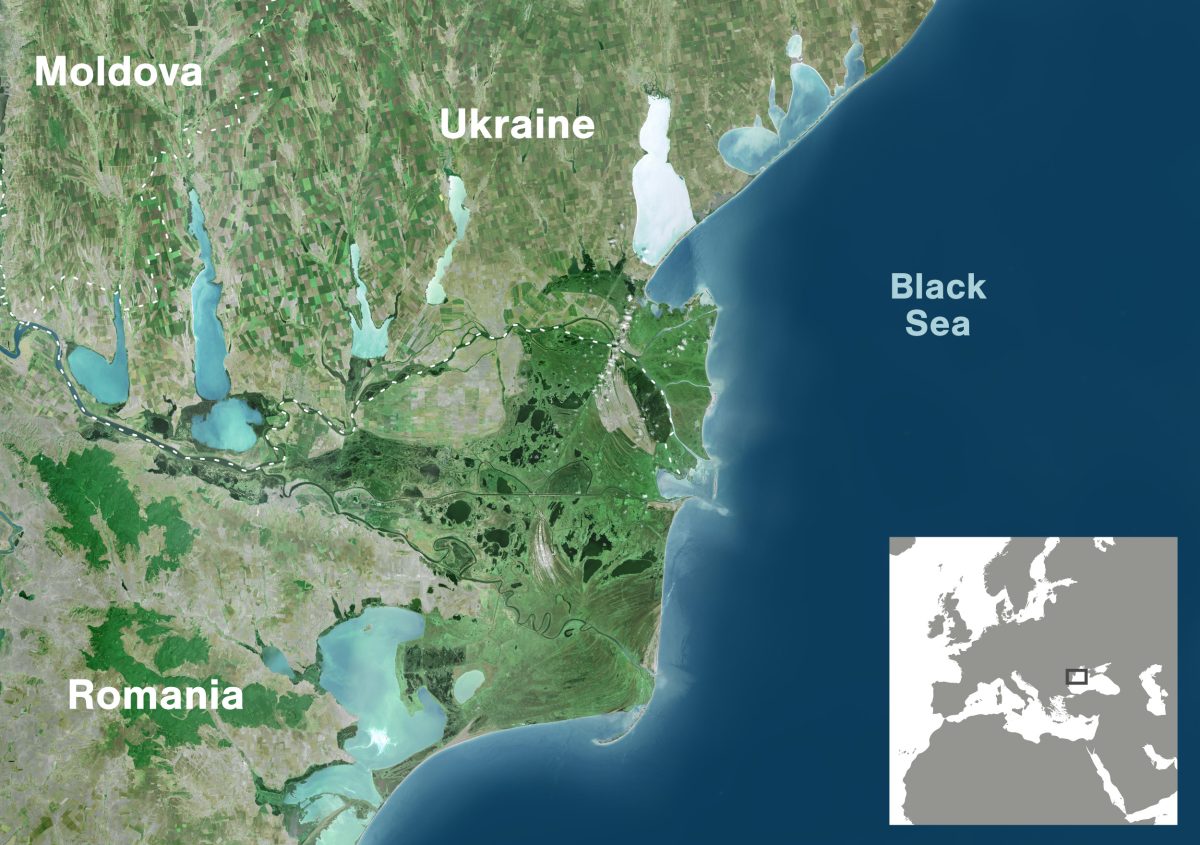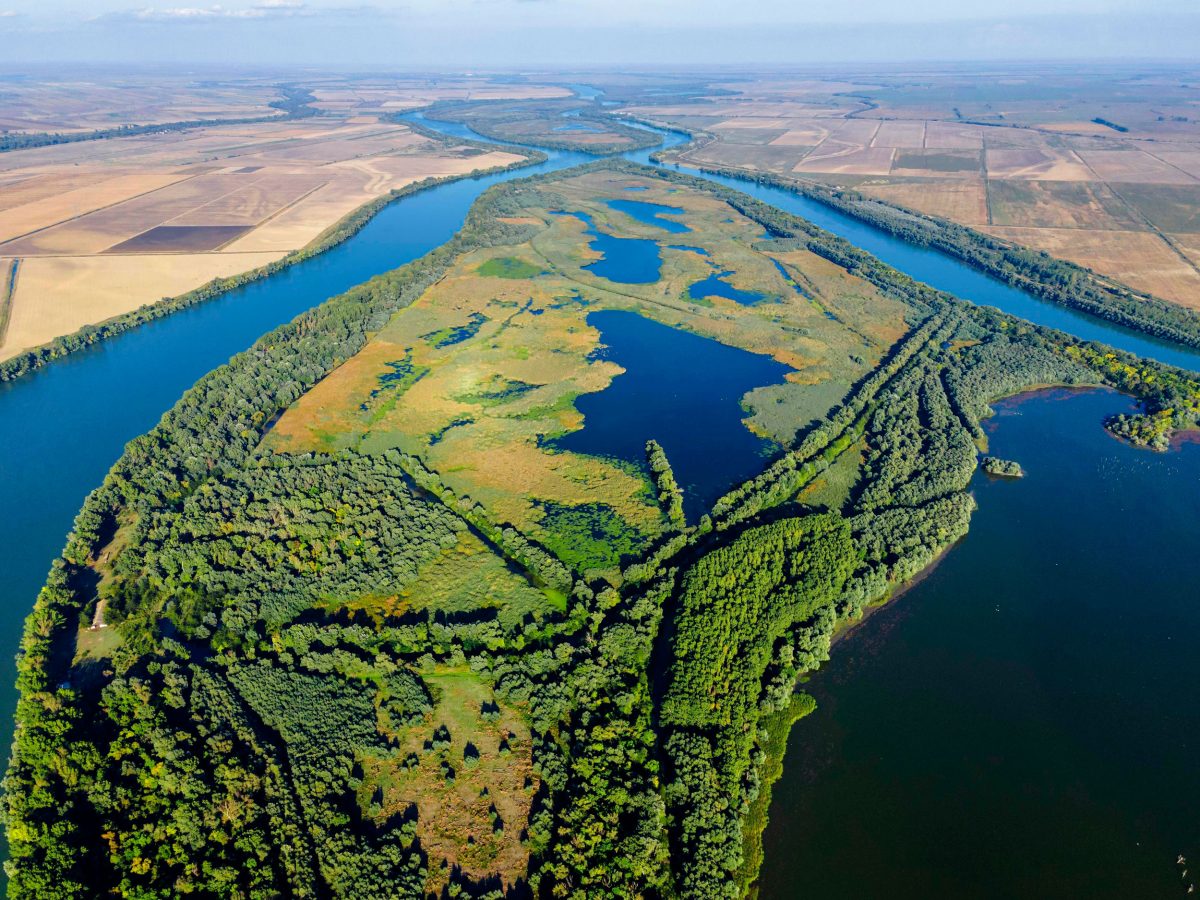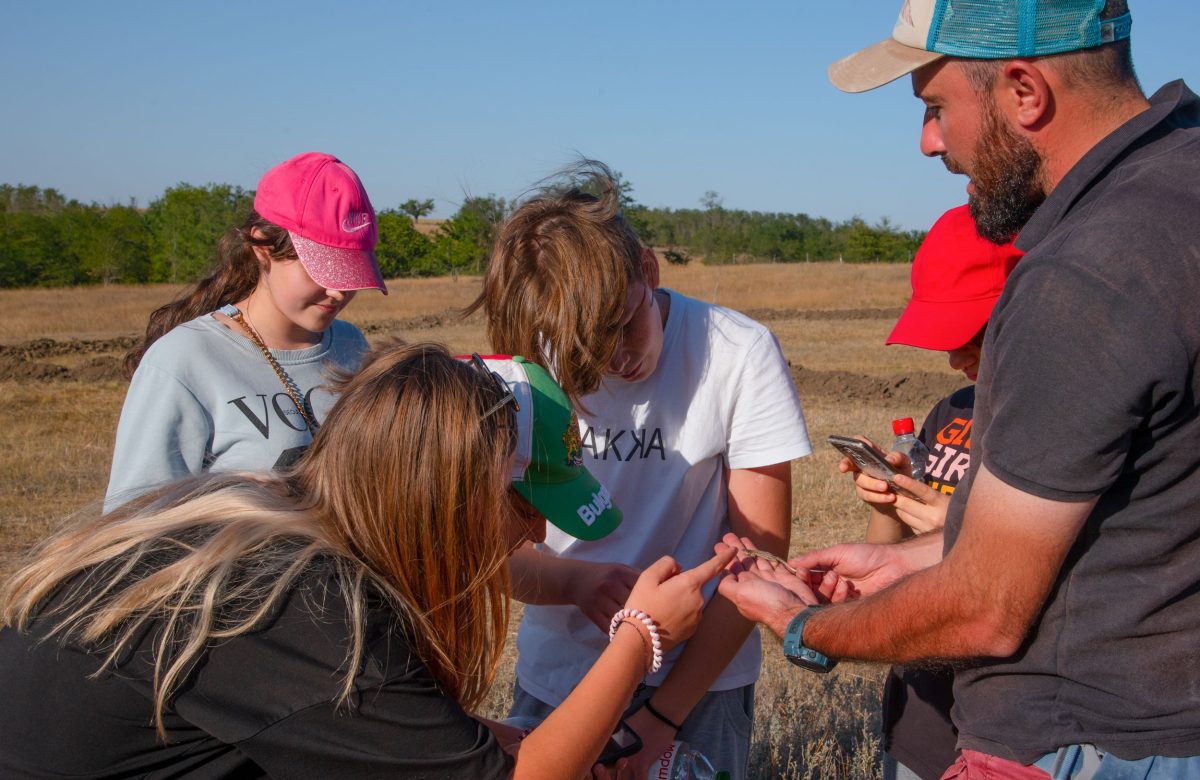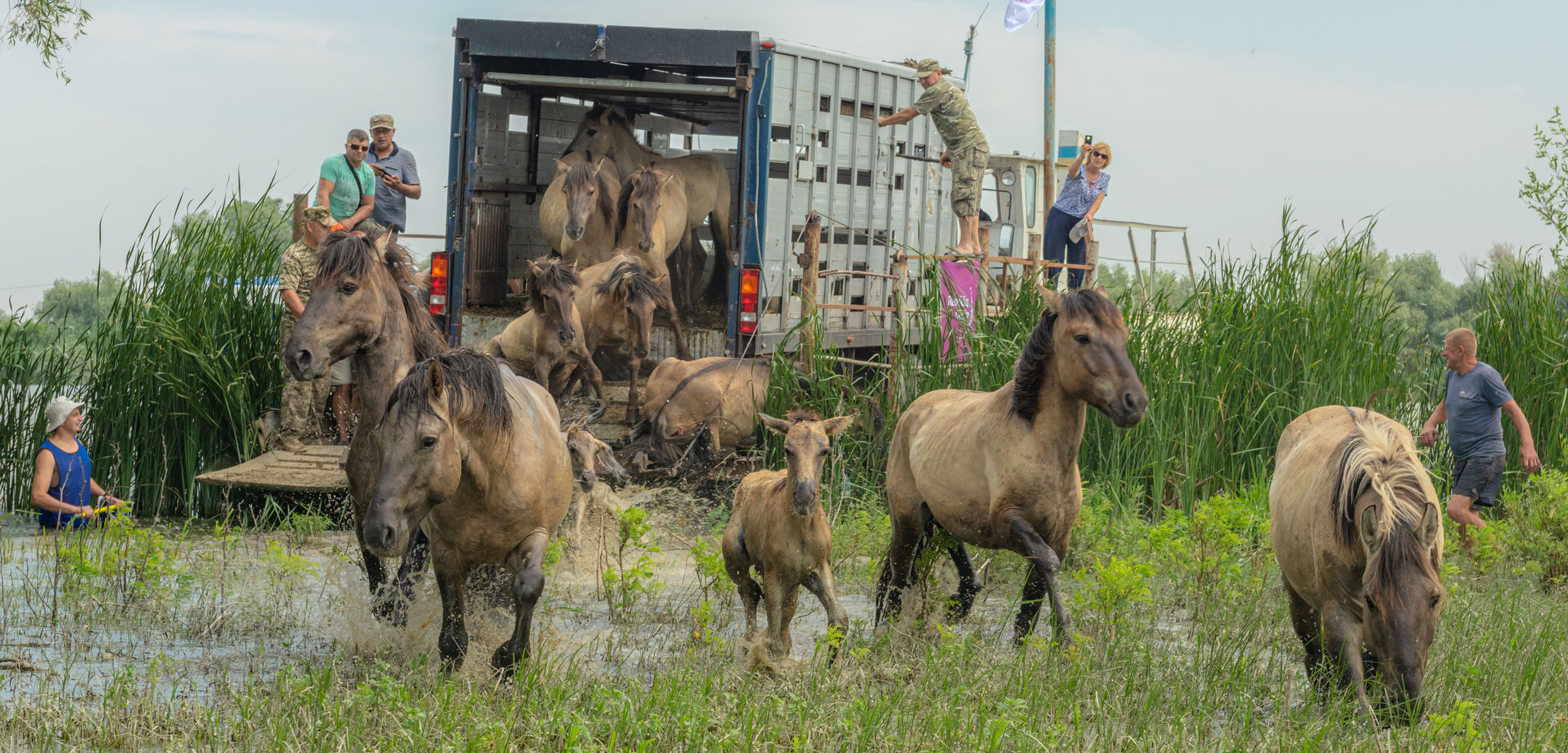Fighting for Wildlife in a Time of War
As conflict rages around them, Ukrainian conservationists persevere in restoring the Danube Delta, one of Europe’s most prized ecosystems.
Article body copy
A livestock truck arrives on a wintry swath of grassland called the Tarutino Steppe in southern Ukraine. When the metal doors on the trailer swing open on this cold night, what emerges is not weaponry or munitions but a herd of donkeys: a type of Asiatic wild ass called kulan.
Once common in eastern Europe and central Asia, kulan (Equus hemionus kulan) have been on the International Union for Conservation of Nature’s Red List of Threatened Species since 1994, with their population now classed as endangered and “severely fragmented.” The 20 donkeys released onto the steppe in late December 2021 were the second such reintroduction—the first was in May of the previous year—as part of an effort to rewild the larger Danube Delta region in Ukraine, Moldova, and Romania. Here, a constellation of organizations, supported by Rewilding Europe, has been working to restore a landscape scarred by industrialization and diminished by overhunting.
A team of Ukrainian conservationists called Rewilding Ukraine has worked with partners at another reserve to oversee the reintroduction of kulan. The second herd of kulan joined the 20 donkeys released in 2020, the first steps toward reaching a population of up to 300 in the next 12 years.
Saiga antelope, fallow deer, and kulan all once roamed the Tarutino Steppe, shaping and creating habitat. Herbivores like these graze on grasses and other vegetation, lowering the risk of wildfires; shorter grasses also benefit smaller creatures such as steppe marmot and souslik, a type of ground squirrel. The return of kulan and other animals is good news for predators, too, primarily wolves, and for the Danube Delta region in general. One of the least populated areas in temperate Europe, this rich delta habitat sprawls across 5,800 square kilometers of Romanian, Moldovan, and Ukrainian territory, an area almost the size of Delaware.

The Danube Delta’s rich wetland habitat brings biodiversity and ecotourism opportunities to three eastern European countries. Photo by Universal Images Group North America LLC/Alamy Stock Photo, map data by ArcGIS
The delta is the terminus for one of Europe’s great rivers. Originating in the mountains of Germany’s Black Forest, the Danube flows through capital cities Vienna, Budapest, and Belgrade, before bisecting the Carpathian Mountains in Romania. From there, it turns to the east, forming the border with Bulgaria. The river then bends to run parallel to the Black Sea before scattering into a vast network of riverlets, lakes, reed beds, and mudflats, ultimately draining into the sea.
Development in the 20th century created canals and dikes that cut off lakes in the delta, but over 4,600 animal and plant species still live in its emerald web. The delta is a welcoming habitat for endangered European mink, at least two species of wild sturgeon, and, along with vast numbers of migratory birds, a population of rare Dalmatian pelicans.
Mykhailo Nesterenko has spent 25 years on rewilding efforts in the delta. Since he helped found Rewilding Ukraine in 2017, he has worked with team members to reintroduce keystone species like kulan, water buffalo, Konik horses, fallow deer, and eagle owls. Along with building wooden nesting platforms for pelicans, the team has also undone some of the Soviet-era damage to the landscape, using excavators and other equipment to remove dikes and reconnect the river and floodplain with one of the major lake systems on the Ukrainian side of the delta.

The kulan released into the Danube Delta are a type of Asiatic wild ass, once found from Mongolia to the Mediterranean. Their former range has shrunk by more than 95 percent in the past two centuries. Photo by Andrey Nekrasov/ZUMA Press, Inc./Alamy Stock Photo
This work all gradually helped strengthen the foundations of a nature-based economy for local people: birdwatching and animal viewing infrastructure for tourists, and an ecopark with excursion routes on the Tarutino Steppe.
But on February 24, 2022, the future of the rewilding initiative—and indeed the future of the delta itself, and the entire country—was cast into doubt: the Russian Federation invaded Ukraine.
Odessa, a port city on the Black Sea—about 150 kilometers northeast of the Danube Delta—came under attack on the first day of the war. Russian fighter jets roared overhead, followed by shelling from land and sea. The bombardment forced thousands of residents including Nesterenko, his family, and Rewilding Ukraine communications officer Kateryna Kurakina to evacuate. After crossing into Moldova and then Romania, they were relocated to the Netherlands, where parent organization Rewilding Europe has its headquarters.
While the Danube Delta was a long way from the front lines, the team remained concerned about the area. “There were statements from Russian high-ranking officials that they’d target the entire coastal areas of the Black Sea,” says Nesterenko.
Even if the delta did not come under direct Russian occupation, the future looked uncertain and fraught with danger. The germinal ecotourism industry, which Nesterenko sees as important to the success of their rewilding initiative, came to a sudden halt. International tourism to the Ukrainian side dried up overnight, says Nesterenko. While exact figures for Ukraine are difficult to find, the number of tourists visiting the Romanian part of the delta fell by one-quarter in the first five months of 2022.
Sea mines have been deployed in the Black Sea by both Ukrainian and Russian forces—part of ongoing naval warfare that included the fight for control of Ukraine’s Snake Island, some 35 kilometers offshore from the delta. Several mines have been swept by tides into the delta’s estuaries, where they have detonated in the rewilding area, causing fires in the dry woodlands. In the summer of 2022, a hydrographic vessel sustained damage from a sea mine within the Ukrainian part of the delta, while a cargo ship hit what appears to have been a sea mine on the Romanian side in September of this year. Fortunately, the crew on both ships survived.
Because of Russia’s stated designs on the Black Sea coast, the area of the delta closest to the sea became a military exclusion zone, and it has remained so. This has proved particularly problematic for the Danube Biosphere Reserve (DBR), a Ukraine-established protected area nestled between the sea and the Romanian border. The DBR is one of Rewilding Ukraine’s key local partners; the two organizations have worked together on a range of projects. One of these was a 2021 collaboration to build floating platforms for Dalmatian pelicans, continuing a project begun by Rewilding Europe and other partners in 2019.

Dalmatian pelicans, shown here on a nesting platform in the delta, are some of the world’s largest flying birds, with wingspans that can exceed three meters. Photo by Laurien Holtjer/Rewilding Europe
According to Maksym Yakovliev, DBR’s deputy director of science, neither his team nor Rewilding Ukraine has investigated the impacts of the bloody fighting that took place during the operation to liberate Snake Island. They haven’t returned to monitor pelican nesting sites or other projects either. The area is too dangerous.
Throughout Ukraine, conservation concerns have given way to a war footing. Bohdan Prots is CEO of the Danube-Carpathian Programme, a conservation organization that has widened its scope to address the humanitarian crisis in the country. “Conservation is for a peaceful life,” says Prots, who also heads the biodiversity department at the State Museum of Natural History in Lviv in western Ukraine. With the war afflicting so much of the country, nature restoration has become impossible in many areas.
War is creating a different kind of wilderness outside the rewilding zone, Prots says: “a wilderness of land mines.” In Ukraine, an estimated 174,000 square kilometers—30 percent of the country, an area about the size of Washington State—is now contaminated with the explosive devices. While they could once be located with metal detectors, Prots says that most of the land mines in Ukraine are primarily made of camouflaged plastic that can blend in with grasslands and the forest floor.
“How can nature be de-mined?” asks Prots. “For the moment, we don’t know.”
While he hopes that drones will revolutionize mine detection, it is unclear whether they will ever be capable of finding the mines in Ukraine’s forests and densely vegetated wetlands.
Fortunately, nearly two years into the war, the Danube Delta has not become part of the deadly wilderness of land mines. Sea mines and drone strikes still pose threats, but Rewilding Ukraine conservationists are continuing to rewild the areas of the delta they can access without too much risk.
The war has displaced millions of Ukrainians. Six million refugees have fled across borders into Poland, Moldova, Hungary, and other countries around the world. Poland alone has welcomed 60 percent of these international refugees. Another five million displaced Ukrainians have relocated to relatively more peaceful areas within Ukraine. Many have settled in towns around the Danube Delta and the Tarutino Steppe. In other parts of the country, such as the Carpathian Mountains, displaced people have moved into the nature reserves themselves, living in repurposed field-research dormitories, visitor centers, and museums.
While the war has been a disaster for ecotourism in the area, Ukrainians are still benefiting from nature psychologically—and ecosystems are also getting some assistance. Recently, Rewilding Ukraine, with their Romanian and Moldovan counterparts, announced the Danube Delta Rewilders Club, aimed at connecting children with nature. Prots and Nesterenko note that people are volunteering in Ukraine’s ongoing conservation efforts from the Carpathians to the Tarutino Steppe.
“When people are in distress, they want to go into nature and do something useful,” says Prots.

Dike removals around Small Tataru Island in the Ukrainian delta have restored fish spawning habitat and made the island a destination for rare white-tailed eagles and pygmy cormorants. Grazing herbivores such as introduced Hungarian grey cattle and Hutsul horses have created new grasslands. Photo by Andrey Nekrasov/imageBROKER/Alamy Stock Photo
Whether volunteer restoration efforts will counterbalance the destructive ecosystem effects of the war remains to be seen, however. Prots points out that in the Danube Delta region and throughout Ukraine, the realities of less money and less law enforcement on the ground could lead to an increase in illegal fishing and hunting as people try to survive.
One thing is for sure: the ecological qualities that make certain areas of Ukraine so important for biodiversity—rivers, peat bogs, estuaries, and forests—have also made them challenging for the invading Russian army.
“The bravery of our people, plus nature, helped to defend the country,” says Prots.
The boggy landscape of the Danube Delta and its surrounding area have given Ukrainians hope that this part of Ukraine will not come under Russian occupation. The recent collapse of the Black Sea Grain Initiative, however, has been followed by a wave of Russian air strikes both in the delta and along the Black Sea coast. Russia’s refusal to guarantee Ukrainian agricultural shipments through the Black Sea has forced Kyiv to reactivate the port of Reni and step up operations at Izmail, both on the Danube, to ship grain into Romania and upriver to countries like Slovakia. While the grain deal stood, these routes accounted for around one-third of agricultural exports. Now the only shipping outlet for millions of tonnes of grain, the delta has been hit by drone and missile strikes, as Russia targets crucial grain-shipping installations.
Plans to dredge a shipping canal in the DBR portion of the delta would once have been completely unacceptable, says Prots. But in the new world of Ukrainian conservation, habitat preservation must be balanced with security concerns. With continued grain shipments vital for Ukraine’s wartime economy, he believes dredging is a small price to pay to avoid protected areas being demolished under Russian occupation, so long as the canal is returned to nature after the war.
“Security comes first now, to protect nature and people,” says Prots.
In the early days of the war, no one knew what the country would look like in a year, nor who would be in control of particular regions. Many conservation initiatives in Ukraine faced a funding freeze, as international partners questioned the value of funding nature restoration in a war zone. Fortunately for Rewilding Ukraine, its funders—the European Union’s LIFE Programme and the Endangered Landscapes and Seascapes Programme—agreed to see how things progressed.
The kulan released by conservationists in late 2021, before the war, were lucky. They came from a reserve only 40 kilometers from Crimea, a province Russia occupied back in 2014. In March 2023, Russian troops officially captured the reserve, a steppe habitat now damaged by heavy military vehicles and equipment. According to the reserve administration in exile, Russian troop activities, including the use of rocket launchers, caused several fires in the reserve and allowed one lightning-sparked fire to burn out of control. In all, nearly 18 square kilometers of the reserve burned.

A new Rewilding Ukraine program educates Ukrainian, Romanian and Moldovan students about the Danube Delta ecosystem and rewilding efforts there, and leads trips to the Tarutino Steppe and other areas. Photo by Maxim Yakovlev/Rewilding Europe
But rewilding continues. By June 2023, the Rewilding Ukraine team and their local partners had completed a four-year project to reconnect one of the largest lake systems in Ukraine’s portion of the Danube Delta by deconstructing a Soviet-era hydro project.
Reconnecting the lakes has restored potential fish spawning grounds and promises new life in the surrounding wetlands. Water samples sent to the United Kingdom from one of the lakes for environmental DNA, or eDNA, testing shows that several species of fish have already come back. As conditions improve, Nesterenko believes these fish will begin spawning.
One of the more charming efforts by the rewilding team is their release of European hamsters. In December 2022 and this past September, they coaxed the charismatic rodents—as long as 30 centimeters and weighing up to half a kilogram—into the wild. Once established, the hamsters will provide prey for raptors and other animals, spread seeds to boost plant biodiversity, and create habitat with their burrows for other animals.
The team is still keen on reintroducing ungulates that will graze and browse vegetation to reduce wildfire risk and nurture a rich ecosystem. This past April, Rewilding Ukraine gave 20 red deer and 20 fallow deer a new home on an island in the delta.
Amid all of this, nature itself has lent a helping hand to the team’s efforts. In the summer of 2022, one of the kulan reintroduced to the Tarutino Steppe—about 340 kilometers west of their original home reserve—gave birth to a foal. This was the first wild kulan born in Europe in 200 years.

